Terrestrial Invasive Species
Potential
Threats
 |
 |
 |
 |
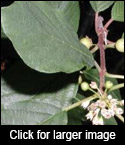 Glossy Buckthorn (Frangula alnus)
Glossy Buckthorn (Frangula alnus)
Growth Form - Glossy buckthorn is a shrub that produces large quantities of fruit every year.
Impacts - It is capable of invading forest ecosystems, wetlands, prairies and other native habitats.
Threats - Glossy buckthorn is shade tolerant and capable of outcompeting native vegetation for resources and can lead to degradation of wildlife habitat. The fruits contain no nutritional value, stain driveways and are known to be cathartic. Populations of buckthorn can make an impenetrable layer of vegetation that is impossible to navigate. It has also been found to be a host for other pests and cause soil erosion. The seed bank can remain viable for up to five years.
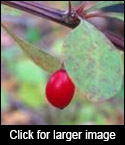 Japanese Barberry (Berberis thunbergii)
Japanese Barberry (Berberis thunbergii)
Growth Form – Japanese Barberry is a shrub that reproduces by seed.
Impacts - It infests hardwood forests with rich well-drained soils; oak woodlands and oak savanna are popular sites of infestation.
Threats - Japanese Barberry is shade tolerant and drought resistant which allows it to outcompete with native vegetation. The dense stands reduce the wildlife habitat and can alter the soil chemistry.
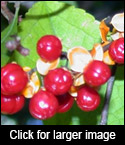 Oriental Bittersweet (Celastrus orbiculatus)
Oriental Bittersweet (Celastrus orbiculatus)
Growth Form – Oriental bittersweet is a woody perennial vine that reproduces by seeds.
Impacts - It invades disturbed, open, sunny sites and open woodlands.
Threats - This vine kills trees and shrubs by strangling, shading or breaking trees with the weight of the vines.
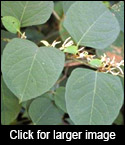 Japanese Knotweed (Polygon cuspidatum)
Japanese Knotweed (Polygon cuspidatum)
Growth Form - Japanese knotweed is a shrub-like, herbaceous perennial that spreads vegetatively and by seed.
Impacts - It is known to aggressively invade riparian areas.
Threats - Japanese knotweed tolerates shade, high temperatures, high salinity and drought. It is capable of creating dense mats which suppress the growth of native vegetation.
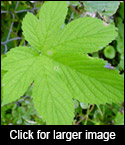 Japanese Hops (Humulus japonicas)
Japanese Hops (Humulus japonicas)
Growth Form - Japanese Hops is an herbaceous annual vine.
Impacts - It prefers riparian areas with full sun, exposed soils that are moist and rich but will invade disturbed roadside soils that are moist.
Threats - Japanese hops can outcompete with native vegetation. It displaces vegetation and prevents the emergences of new plants. It can infest trees and shrubs to the point that they are weighted down causing them to break or bend.
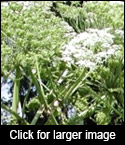 Giant Hogweed (Heracleum mantegazzianum)
Giant Hogweed (Heracleum mantegazzianum)
Growth Form - Giant hogweed is a giant herbaceous biennial that produces up to 1500 seeds in its second year.
Impacts - It is known to invade moist soils of woodlands and riparian zones.
Threats - The major concern is the sap of giant hogweed that can cause blistering similar to wild parsnip. It outcompetes with native vegetation and also known to cause soil erosion.
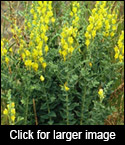 Dalmatian Toadflax (Linaria dalmatica)
Dalmatian Toadflax (Linaria dalmatica)
Growth Form – Dalmatian toadflax is a short-lived herbaceous perennial that reproduces by vegetative buds and seed, with a single plant producing up to 500,000 seeds.
Impacts - It invades disturbed areas with a preference for coarse, well-drained soils.
Threats - It invades and outcompetes against native vegetation. The seed bank remains viable for up to 10 years.
It is a short-lived herbaceous perennial plant that invades disturbed areas with a preference for coarse, well-drained soils.
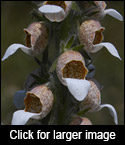 Grecian Foxglove (Digitalis lanata)
Grecian Foxglove (Digitalis lanata)
Growth Form – Grecian foxglove is an herbaceous perennial that reproduces numerous seeds
Impacts - It invades full to partial sun along roads, woodland edges and in open fields.
Threats - This plant contains a toxin that is harmful to livestock and humans, which can be absorbed through the skin. It threatens the habitat of savanna and prairies communities. The seed bank remains viable for 3 to 4 years.
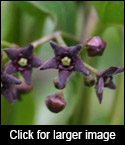 Black Swallow-Wort (Cynanchum louiseae)
Black Swallow-Wort (Cynanchum louiseae)
Growth Form - Black-swallow wort is an herbaceous perennial vine.
Impacts - It prefers full sun in upland soils; grows aggressively in forests, grasslands and savannas.
Threats - It is known to form dense patches that crowd out competition as well as have a negative impact on monarch butterflies.
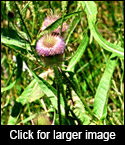 Common Teasel (Dipsacus fullonum)
Common Teasel (Dipsacus fullonum)
Growth Form – Common teasel is an herbaceous perennial that dies after producing seeds, with each flower head producing approximately 2000 seeds.
Impacts - It invades disturbed, open areas that are sunny. It can be found commonly by roadsides and disturbed areas.
Threats - It outcompetes with native vegetation. The seeds remain viable for up to two years.
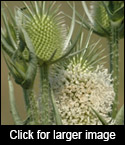 Cut-Leaved Teasel (Dipsacus laciniatus)
Cut-Leaved Teasel (Dipsacus laciniatus)
Growth Form – Cut-leaved teasel is an herbaceous perennial that dies after producing seeds, with each flower head producing approximately 2000 seeds.
Impacts - It invades disturbed, open areas that are sunny. It can be found commonly by roadsides and disturbed areas.
Threats - It outcompetes with native vegetation. The seeds remain viable for up to two years.
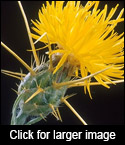 Yellow Starthistle (Centaurea solstitialis)
Yellow Starthistle (Centaurea solstitialis)
Growth Form – Yellow starthistle is an herbaceous annual that reproduces by seed with each flower producing between 35 to 80 seeds.
Impacts - It aggressively invades prairies, fields, woodlands and pastures.
Threats - It displaces native vegetation, creates monocultures and can reduce soil moisture. The spines can cause injury to livestock that graze. It is also toxic to horses.
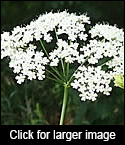 Burnet Saxifrage (Pimpinella saxifrage)
Burnet Saxifrage (Pimpinella saxifrage)
Growth Form – Burnet saxifrage is an herbaceous perennial from the carrot family that is capable of self- fertilizing and has high seed production.
Impacts - It invades grasslands and woodlands, with a preference for dry, well-drained calcareous soils.
Threats - It is capable of taking over areas of land and creating large mats that don’t allow for anything else to grow.
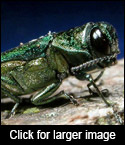 Emerald Ash Borer (Agrilus planipennis)
Emerald Ash Borer (Agrilus planipennis)
Impacts - Emerald ash borer infests all types of North American ash trees.
Threats - A single female is capable of laying up to 250 eggs. The larval stage feeds on the inner bark of ash trees, which affects the ability of the tree to transport water and nutrients. Minnesota has a population of over 900 million ash trees. The emerald ash borer threatens the composition of the forest. It has been found in southern Minnesota, but has not arrived on the Leech Lake Reservation yet. Transportation of firewood and trees with bark on are the most probable means of spreading this exotic.
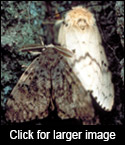 Gypsy Moth (Lymantria dispar dispar)
Gypsy Moth (Lymantria dispar dispar)
Impacts - Gypsy moth invests various types of forest, but prefers rich hardwood forests. Aspen and oaks are the preferred host trees.
Threats – A female can produce an egg mass with between 600 to 1000 eggs. The caterpillars are known to defoliate an entire tree. By repeatedly defoliating a tree, it leads to the death of the tree.
Contact Us
DRM (218) 335-7400
| Name | Title | Phone |
| Mortensen, Steve | Fish, Wildlife & Plant Resources Program Director | 335-7421 |
| Katie Zlonis | Botanist/Invasive Species Program Manager | 335-7442 |
| Finn, Jon | Fish & Wildlife Field Specialist | 335-7424 |
| White, Gary | Assistant Hatchery Manager | 335-7424 |
| Robinson, Martin | Fish and Wildlife Technician | 335-7424 |















 Division of Resource Management
Division of Resource Management